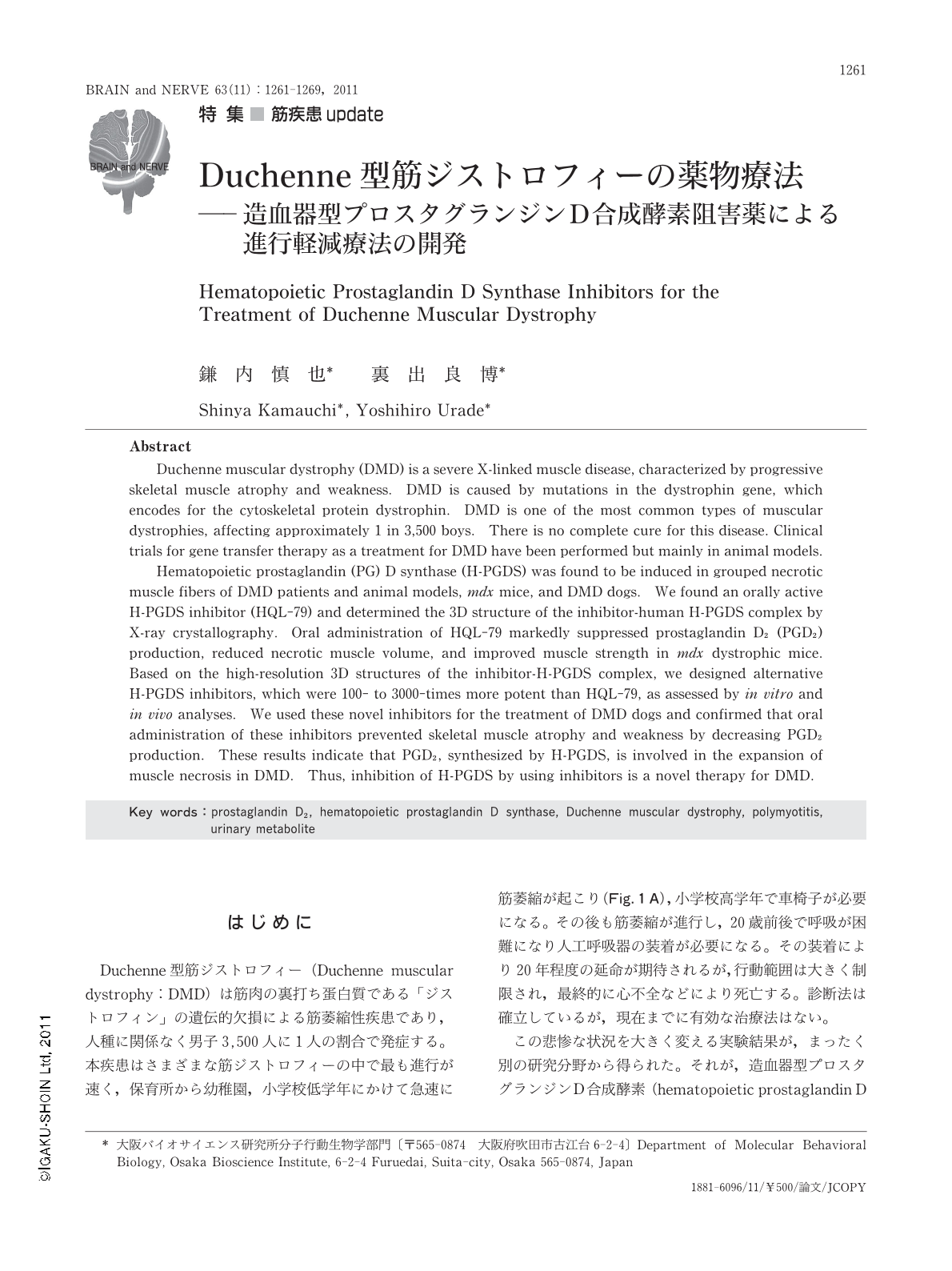Japanese
English
- 有料閲覧
- Abstract 文献概要
- 1ページ目 Look Inside
- 参考文献 Reference
はじめに
Duchenne型筋ジストロフィー(Duchenne muscular dystrophy:DMD)は筋肉の裏打ち蛋白質である「ジストロフィン」の遺伝的欠損による筋萎縮性疾患であり,人種に関係なく男子3,500人に1人の割合で発症する。本疾患はさまざまな筋ジストロフィーの中で最も進行が速く,保育所から幼稚園,小学校低学年にかけて急速に筋萎縮が起こり(Fig.1A),小学校高学年で車椅子が必要になる。その後も筋萎縮が進行し,20歳前後で呼吸が困難になり人工呼吸器の装着が必要になる。その装着により20年程度の延命が期待されるが,行動範囲は大きく制限され,最終的に心不全などにより死亡する。診断法は確立しているが,現在までに有効な治療法はない。
この悲惨な状況を大きく変える実験結果が,まったく別の研究分野から得られた。それが,造血器型プロスタグランジンD合成酵素(hematopoietic prostaglandin D synthase:H-PGDS)阻害薬による進行軽減療法の開発である。以下に,その研究成果を紹介する。
Abstract
Duchenne muscular dystrophy (DMD) is a severe X-linked muscle disease, characterized by progressive skeletal muscle atrophy and weakness. DMD is caused by mutations in the dystrophin gene, which encodes for the cytoskeletal protein dystrophin. DMD is one of the most common types of muscular dystrophies, affecting approximately 1 in 3,500 boys. There is no complete cure for this disease. Clinical trials for gene transfer therapy as a treatment for DMD have been performed but mainly in animal models.
Hematopoietic prostaglandin (PG) D synthase (H-PGDS) was found to be induced in grouped necrotic muscle fibers of DMD patients and animal models,mdx mice,and DMD dogs. We found an orally active H-PGDS inhibitor (HQL-79) and determined the 3D structure of the inhibitor-human H-PGDS complex by X-ray crystallography. Oral administration of HQL-79 markedly suppressed prostaglandin D2 (PGD2) production,reduced necrotic muscle volume,and improved muscle strength in mdx dystrophic mice. Based on the high-resolution 3D structures of the inhibitor-H-PGDS complex,we designed alternative H-PGDS inhibitors,which were 100- to 3000-times more potent than HQL-79,as assessed by in vitro and in vivo analyses. We used these novel inhibitors for the treatment of DMD dogs and confirmed that oral administration of these inhibitors prevented skeletal muscle atrophy and weakness by decreasing PGD2 production. These results indicate that PGD2,synthesized by H-PGDS,is involved in the expansion of muscle necrosis in DMD. Thus,inhibition of H-PGDS by using inhibitors is a novel therapy for DMD.

Copyright © 2011, Igaku-Shoin Ltd. All rights reserved.


